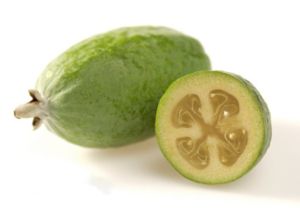Cookbook:Feijoa
| Feijoa | |
|---|---|
 | |
| Category | Fruits |
Cookbook | Recipes | Ingredients | Equipment | Techniques | Cookbook Disambiguation Pages | Ingredients | Fruit
The feijoa or pineapple guava[1][2] is a fruit native to South America but now commercially grown in New Zealand and California.
Characteristics
[edit | edit source]The fruit is egg-shaped, with a thin lime-green skin.[1][3] The flesh inside is cream-colored and encases a jelly-like center with small seeds.[2][4] The texture is gritty,[4] close to that of a pear. The flesh tastes like a combination of several other fruits, usually described as pineapple, guava, and strawberry, with hints of mint or eucalyptus.[1][3][4] Some people report a taste similar to that of a quince or lemon.
Seasonality
[edit | edit source]Feijoa season begins in the fall—this means around September in the northern hemisphere and around March in the southern.[1]
Selection and storage
[edit | edit source]Because the fruits don't significantly change color to indicate ripeness, go by touch: choose fruit that is fragrant and gives slightly to gentle pressure. It should come off the plant easily.[5] You'll know the fruit is ripe when it is slightly soft and the jellied inner section is clear—if clear, it's underripe, and excessive browning means it's past its prime. Ripe feijoas are delicate, so take caution not to bruise the fruit. In some regions, feijoas are gaining in popularity and are becoming easier to find in supermarkets. They are already easy to find in specialty markets and can often be ordered out-of-season through several online merchants.
Ripe feijoas may be refrigerated, but they don’t have to be. Ripen feijoas in a paper bag at room temperature; to ripen more quickly, add an apple to the bag. Ripe feijoas normally last about 3–5 days. Feijoas may be frozen, but only after peeling and cooking into a purée.
Preparation
[edit | edit source]Feijoas are pretty easy to prepare. Start by slicing or tearing the fruit in half, then scoop out the inner flesh.[1][5] You can also peel off the bitter outer skin, though it is technically edible.[1]
Use
[edit | edit source]The most common use for feijoas is simply eating raw, either plain or as a salad or garnish.[1][2][3] However, they can also be cooked into creams, jams, and cakes.[2][4]
Recipes
[edit | edit source]References
[edit | edit source]- ↑ a b c d e f g Friberg, Bo (2016-09-13). The Professional Pastry Chef: Fundamentals of Baking and Pastry. Wiley. ISBN 978-0-470-46629-2.
- ↑ a b c d Evans, Kate; Chypsanava, Tatsiana (2024-04-13). "New Zealanders Are Crazy for This Fruit. It’s Not the Kiwi." (in en-US). The New York Times. ISSN 0362-4331. https://www.nytimes.com/2024/04/12/world/australia/new-zealand-feioja-kiwis.html.
- ↑ a b c Rinsky, Glenn; Rinsky, Laura Halpin (2008-02-28). The Pastry Chef's Companion: A Comprehensive Resource Guide for the Baking and Pastry Professional. John Wiley & Sons. ISBN 978-0-470-00955-0.
- ↑ a b c d Davidson, Alan (2014-01-01). Jaine, Tom (ed.). The Oxford Companion to Food. Oxford University Press. doi:10.1093/acref/9780199677337.001.0001. ISBN 978-0-19-967733-7.
- ↑ a b "Feijoa - You can eat that?". ANR Blogs. Retrieved 2024-07-14.
